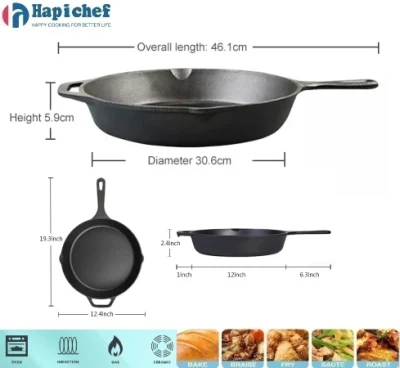rusty cast iron skillet
The Timeless Charm of a Rusty Cast Iron Skillet
Cast iron skillets have been a beloved cooking tool for generations, cherished for their durability, versatility, and unique ability to retain heat. Among these kitchen treasures, a rusty cast iron skillet may seem less appealing at first glance, but it carries a charm and history that is hard to ignore. This article explores the significance of rusty cast iron skillets, their restoration, and the cooking experiences they offer.
A Journey Through Time
The history of cast iron skillets dates back to ancient times, but they gained popularity in the 18th and 19th centuries. These skillets were prized possessions in many households, often passed down through generations. A rusty cast iron skillet tells a story—each speck of rust is a testament to the meals cooked, the family gatherings celebrated, and the decades of love it has received.
Rust is often viewed as a flaw, a sign of neglect or disrepair. However, in the context of cast iron, rust is a natural occurrence that happens when moisture interacts with iron. A rusty skillet should not be discarded; instead, it presents an opportunity for restoration and rejuvenation. The process of bringing a rusty skillet back to life becomes a form of culinary therapy. It connects us to our culinary heritage while teaching us the value of care and patience.
The Restoration Process
Restoring a rusty cast iron skillet might sound daunting, but it is a straightforward process that requires a few simple tools and ingredients. Here’s how to breathe new life into a neglected piece of cookware
1. Cleaning the Skillet Begin by removing any loose rust using steel wool or a wire brush. This may take some effort, but it’s crucial for a smooth surface. Wash the skillet with hot, soapy water to remove any remaining debris.
rusty cast iron skillet

2. Seasoning Once cleaned, it’s essential to season the skillet to create a non-stick surface and protect it from future rust. Coat the skillet with a thin layer of vegetable oil or melted shortening. Place it upside down in an oven preheated to 375°F (190°C) for about an hour. This process helps the oil bond to the iron, creating a protective layer.
3. Maintenance Regular upkeep is vital. After each use, clean the skillet with hot water (avoid soap), dry it thoroughly, and apply a light coat of oil. This routine maintains the skillet’s seasoning, ensuring it remains rust-free and ready for your next culinary adventure.
Culinary Versatility
One of the most rewarding aspects of cooking with a cast iron skillet, rusty or not, is its versatility. From searing meats to baking cornbread, the skillet can tackle a variety of recipes with ease. The even heat distribution allows for perfect browning, while the natural non-stick surface improves with each use.
Moreover, cooking with a cast iron skillet encourages traditional kitchen skills. It invites you to connect with the ingredients and the cooking process, often resulting in dishes that taste even better due to the nostalgia associated with using a well-loved piece of cookware.
Conclusion
In a world dominated by non-stick pans and disposable kitchenware, a rusty cast iron skillet stands as a reminder of the timeless joy of cooking. It embodies resilience, history, and the beauty of imperfection. Rather than viewing rust as an obstacle, consider it an invitation to restore, revitalize, and reconnect with your culinary roots. Every scratch and speckle tells a story, making each meal cooked in such a skillet not just a feast for the body, but a celebration of culinary heritage. Embrace the charm of rust, and you'll discover that the love put into restoring a cast iron skillet is often reflected in the meals shared around your table.
-
Why Every Home Cook Needs a Cast Iron Meat PressNewsNov.12,2024
-
Unlock Perfectly Seared Steaks with the Cast Iron Meat PressNewsNov.12,2024
-
Master the Art of Cooking Thick Cuts of Meat with a Cast Iron Meat PressNewsNov.12,2024
-
How to Care for Your Cast Iron Meat Press: Tips for Longevity and PerformanceNewsNov.12,2024
-
How a Cast Iron Meat Press Enhances the Flavor and Texture of Your BurgersNewsNov.12,2024
-
Roasting Pan for Perfect MealsNewsNov.04,2024
-
Perfect Skillet for SaleNewsNov.04,2024
